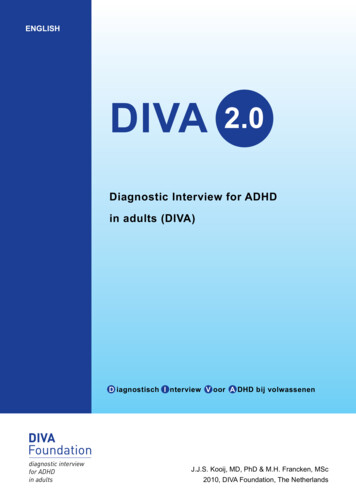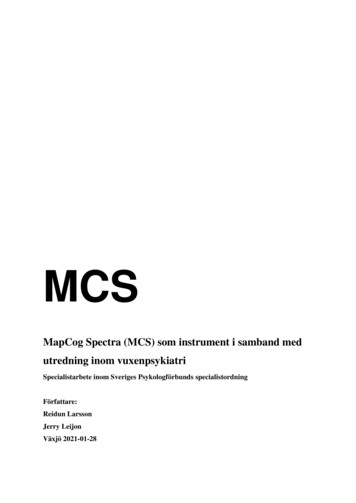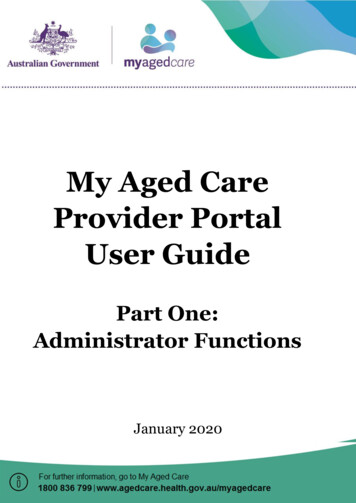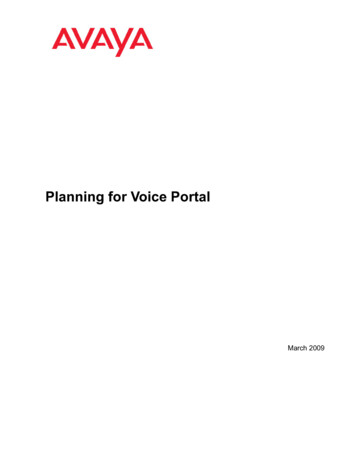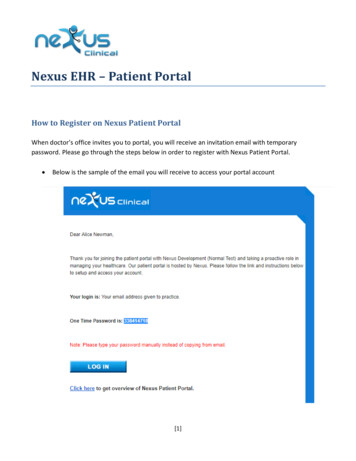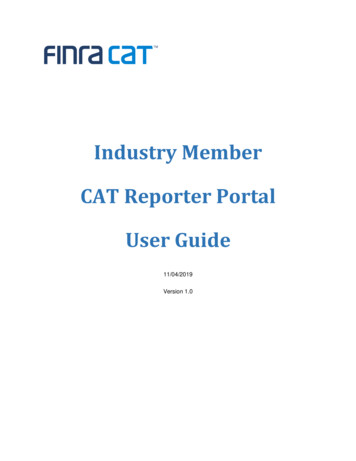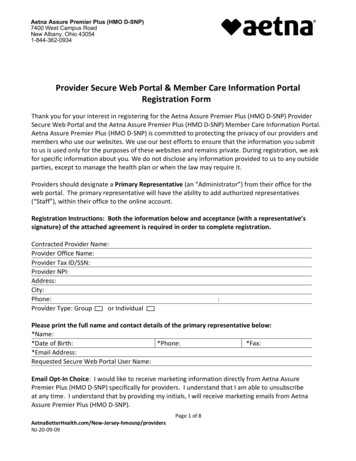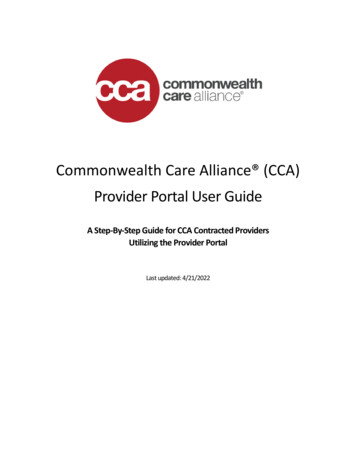
Transcription
To my parents
List of PapersThis thesis is based on the following papers, which are referred to in the textby their Roman numerals.IBlom Johansson, M., Carlsson, M., & Sonnander, K. (2012).Communication difficulties and use of communication strategies:from the perspective of individuals with aphasia. InternationalJournal of Language & Communication Disorders, 47(2), 144-155.DOI:10.1111/j.1460-6984.2011.00089.xIIBlom Johansson, M., Carlsson, M., Östberg, P., & Sonnander, K.(2012). Communication changes and SLP-services according tosignificant others of persons with aphasia. Aphasiology, iFirst,1-24. DOI:10.1080/02687038.2012.671927IIIBlom Johansson, M., Carlsson, M., & Sonnander, K. (2011).Working with families of persons with aphasia: a survey of Swedish speech and language pathologists. Disability & Rehabilitation,33(1), 51-62. DOI:10.3109/09638288.2010.486465IVBlom Johansson, M., Carlsson, M., Östberg, P., & Sonnander, K.A multiple-case study of a family-oriented intervention practice inthe early rehabilitation phase of persons with aphasia. Submitted.Reprints were made with permission from the respective publishers.
ContentsPrologue . 11Introduction . 13Aphasia . 13Definition, aetiology and natural course . 13Psychosocial consequences of aphasia . 16Communication . 19The importance of communication . 19Communication and its components . 20Aphasia rehabilitation services . 27Different approaches of aphasia rehabilitation . 27Family-oriented SLP services . 30Current practice . 33Rationale for this thesis . 35Overall and specific aims . 36Methods and materials . 37Quantitative and qualitative research approaches . 37Research methods and designs . 37Study settings . 38Participants . 39Materials and procedure . 40Study I. 40Study II . 40Study III . 43Study IV . 44Data analyses . 47Qualitative analyses (I, II, III, IV) . 47Statistical analyses (II, III) . 48Graphical analysis (IV) . 48Ethical considerations . 48Results . 50Experiences of persons with aphasia (study I) . 50Experiences of having conversations. 50Managing communication difficulties . 50Factors perceived to facilitate or hinder conversations. 52
Experiences of significant others (study II) . 52Perceived changes in communication . 53Experiences of SLP services . 53Opinions about SLP services . 53Differences between sub-groups. 54Experiences of speech-language pathologists (study III) . 55Family-oriented SLP services . 55Professional experience . 56The intervention (study IV) . 56Intervention format . 57Material and measures . 57Intervention content . 57Intervention outcome . 58Discussion . 60Changes in everyday life conversations . 60The use of communication strategies . 63Family-oriented SLP services . 67Significant others’ motivation to be involved in SLP services . 68The intervention study . 69Methodological considerations. 72Rigour (II, III, IV) . 72Trustworthiness (I, IV) . 74Involving people with aphasia in research . 75Conclusions and implications. 76Future research . 78Svensk sammanfattning (summary in Swedish) . 80Bakgrund . 80Metod . 81Resultat . 82Slutsatser och förslag till åtgärder . 84Acknowledgement . 85References . 88
Abbreviations and definitionsCP(s)CPTCSDiKPwA(s)SaSSLOFSiKSLP(s)SLP servicesSO(s)TPOUAKVASWHOCommunication strategiesSupportive conversation strategiesTotal communication strategiesConversation Partner(s)Communication Partner TrainingCommunication StrategiesParticipation in Conversation [Delaktighet i Konversation]Person(s) with AphasiaEstimation of Conversation Ability[Skattning av Samtalsförmåga]Svenska Logopedförbundet (theSwedish professional association andtrade union)Support in Conversation [Stöd iKonversation]Speech and Language Pathologist(s)Speech and Language PathologyservicesSignificant other(s)Time post-onset (of aphasia)Understanding of Aphasia and Communication [Uppfattning om Afasioch Kommunikation]Visual Analogue ScaleWorld Health OrganisationA generic term that includes Supportive conversation strategies and Totalcommunication strategiesCommunication strategies used bythe conversation partner withoutaphasiaCommunication strategies used bythe person with aphasia
PrologueIn 1992, I took my first steps as a newly educated speech-language pathologist. Since then, I have been working with persons with aphasia in differentsettings and in different phases of rehabilitation. During all these years, Ihave met many significant others. Their importance for the everyday life ofpersons with aphasia has become increasingly evident to me. Professor PeterWährborg was a pioneer in the realm of family-oriented interventions ofpersons with aphasia1. During my pre-graduation studies, he emphasised thesituation of family members of persons with aphasia and their need of support. The everyday life situation of significant others of persons with aphasiaand their need for knowledge and support became even more evident when,in the winter of 2006, I interviewed partners of persons who had beenstricken with aphasia in their mid-lives2. Their narratives touched me deeply;not least their frustration of not being understood by their partner with aphasia or not being able to understand what their partner with aphasia was tryingto say.The ability to communicate is of utmost importance. According to Matsumoto3, communication is the fundamental process by which humans live as social animals. Becauseof communication we can come together to build families, social networks,and professional associations. Because of communication we can work withvery different others toward a common goal. Because of communication wecan organize sports, leisure, and recreational activities3 (p. ix)As a language disorder, aphasia affects the ability to communicate, withsometimes devastating consequences for everyday life of the person withaphasia but also of the significant others. Knowledge about how communication changes in the everyday life of persons with aphasia and their significant others is surprisingly scarce, as is knowledge about current practice ofaphasia rehabilitation.This thesis focuses on conversations between persons with aphasia and theirsignificant others, primarily their partners. What problems do they encounterwhen having conversations? What do they do to solve these problems? Whathelp do they get and what help is possible to offer?11
IntroductionThe introduction consists of three major parts. First, aphasia is defined anddescribed in terms of aetiology, prevalence, symptoms, and everyday lifeconsequences of individuals with aphasia and their significant others. Second, the concept of communication and related concepts are defined. Thissecond part begins with a description of the importance of communicationwith regards to relationships and identity. The third part concerns aphasiarehabilitation services. Different approaches to aphasia rehabilitation arebriefly described, with family-oriented interventions described in more detailbecause this type of aphasia rehabilitation is of special concern to the subjectof this thesis. This third part ends with a summary of our knowledge of current practice. Finally, a rationale for this thesis is presented.AphasiaDefinition, aetiology and natural courseAphasia is defined as “a language disorder caused by acquired brain damage”4 (p. 101). This means a totally or partly impaired ability to speak, read,write, and comprehend spoken language. Aphasia is most often caused bystroke (traditionally estimated to 85%, although this figure does not includeaphasia caused by neurodegenerative diseases). Other possible causes arehead trauma and brain tumour, infections, and neurodegenerative diseases5.In Sweden, about 30,000 persons suffer from stroke each year6, and the incidence of aphasia after stroke is about 30% in the acute phase7-9. Existingestimations of the incidence and prevalence of aphasia are based on the incidence and prevalence of stroke10. Based on the figures presented by Codeand Petheram10 and a Swedish population of about 9,500,000 persons11,about 5000 Swedes are stricken by aphasia because of stroke each year (incidence: 0.05%*) and about 33,000 Swedes have a stroke-induced aphasia(prevalence: 0.34%†). About 80% of the stroke victims are 65 years or older.There is no sex difference in the total group of stroke victims, but in the*0.05% is a mean calculated from the different calculations of incidence presented in thearticle by Code and Petheram10 0.02%, 0.043%, 0.057%, 0,06, and 0.066%†0.34% is a mean calculated from the different calculations of prevalence presented in thearticle by Code and Petheram10 0.32%, and 0.37%13
younger group (below the age of 65 years) about two thirds are men andamong stroke victims above the age of 85, two thirds are women6.The results of different studies somewhat vary depending on assessmenttime and measures, but about one third of stroke survivors with aphasia haverecovered from aphasia 12 to 18 months post-onset, whereas about 60%have a substantial remaining aphasia7, 12, 13. Initial aphasia severity and therecovery during the first weeks after stroke are a good predictor of the outcome14. Spontaneous recovery substantially decreases after three months andplateaus at about six months post-onset7, 13. However, language and communicative skills can sometimes improve even years after onset as a result oftraining10, 15.Symptoms and categorisationAphasia is most often a consequence of a lesion in the left cerebral hemisphere. Symptoms of aphasia could be detected at all linguistic levels, suchas at the phonological (sound), morphological and syntactical (grammar),lexical (word), and pragmatic (use) level. Typical symptoms are literalparaphasias (addition, deletion, or substitutions of phonemes), verbalparaphasias (word substitutions), neologisms (newly made-up words), perseverations (repetitively uttering the same word or syllable), agrammatism(defined as “sparseness of grammatical structure, typically involving short orincomplete sentences and omission or substitution of syntagmatic (function)words and grammatical morphemes”4 (p. 60)), anomia (“difficulties in finding ‘content words’”4 (p. 80) (i.e., nouns, verbs, and adjectives)), and reduced comprehension of spoken and written words, sentences, and discourses (texts)4.Aphasia can be categorised into different sub-types depending on symptom constellations or localisation of the brain lesion4. Two common categorisations (both used in Sweden) are (A) the Boston (neo-classical) classification based on the reintroduction of the Wernicke-Lichtheim model16, 17 by theBoston neurologist Norman Geschwind18 and (B) the classification according to the Russian physician and neuropsychologist Alexander R Luria andhis theory on functional systems19 (Table 1). In addition, dichotomised categorisations could be done in terms of fluency (non-fluent and fluentaphasia20, 21) and location (anterior and posterior aphasia22) (Table 1). Thelatter refers to lesion sites that are predominantly in front of or behind thecentral sulcus.Anterior aphasia is characterised by non-fluent effortful and slow spontaneous speech with short phrase length23. Word finding difficulties (anomia)are common, especially for verbs. Grammar is often incorrect (agrammatism), especially function words (e.g., prepositions, conjunctions, and articles) and word inflections are missing or misused. The ability to write iscompromised in the same way. Language comprehension is also affected,particularly regarding more complex grammar, but usually not to the same14
degree as speech and writing abilities. Broca’s aphasia is a typical anterioraphasia.Table 1. Classification of aphasia according to neo-classical (Boston) and functional system (Luria) theoriesDichotomisationNeo-classical (Boston)Functional systems (Luria)Anterior / non-fluent /expressiveBroca’s aphasiaEfferent motor aphasiaTranscortical motor aphasiaGlobal aphasiaConduction aphasia (subcortical)Wernicke’s aphasiaDynamic aphasiaPosterior / fluent /receptiveAfferent motor aphasiaAcoustic-gnostic (Sensory)aphasiaTranscortical sensory aphasia Acoustic-mnestic aphasiaAnomic aphasiaSemantic (Amnestic) aphasiaIn posterior aphasia, speech is often rather fluent or even exuberant(“with an irrepressible intention of the speaker to continue his monologue”24(p. 145)), but although the grammatical rules are correctly used, speech isoften tangled, characterised by self-interruptions, restarts, circumlocutions,and unsystematic substitutions or omissions of grammatical morphemes.Thus, speech is labelled paragrammatic23, 25. Literal and verbal paraphasiasas well as neologisms may be frequent. Word finding difficulties are common. In addition, language comprehension is often compromised, especiallythe ability to comprehend spoken language. A typical example of posterioraphasia is Wernicke’s aphasia. An excerpt from Kearns23 demonstrates thedifference between anterior and posterior aphasia:In response to the request ‘Tell me what you do with a cigarette,’ a personwith chronic Broca’s aphasia replied, ‘Uh. uh. cigarette [pause] smoke it.’ - - In response to the same request, a patient with chronic Wernicke’s replied,‘This is a segment of a pigment. Soap a cigarette.’ (p. 125)When extensive parts of both the anterior and posterior regions of the brainare affected by stroke, the aphasia is categorised as global26. Verbal output isthen often limited to automatic phrases (such as “I mean that.”) and stereotypic utterances (such as “te-te-te”) and language comprehension skills areseverely impaired23.Another dichotomisation of aphasia - expressive and receptive‡ aphasia21,27– is sometimes used. Expressive aphasia corresponds with anterior aphasiaand receptive aphasia with posterior aphasia (Table 1). However, if the terms“expressive” and “receptive” are seen as symptoms rather than syndromes,they can be misinterpreted as indicating that either the expressive language‡In Swedish: “expressiv” och “impressiv” afasi15
abilities (to talk and to write) or the receptive language abilities (to comprehend spoken and written language) are disturbed, whereas most often bothexpressive and receptive language abilities are disturbed to some extent. Thisdichotomisation is not recommended.The degree of aphasia varies widely among individuals with aphasia fromimmense difficulties with using all language modalities to being hardly noticeable in everyday conversations28.Psychosocial consequences of aphasiaThe consequences of living with aphasia and also certain kinds of aphasiarehabilitation services are often referred to as ”psychosocial” without furtherdefinition of the concept29. According to a medical dictionary definition30,psychosocial pertains to “a combination of psychological and social factors”(p. 1430). Psychological factors, in turn, relate to cognition (the mind) andemotion31 while social factors pertain to societies or other groups of people30. Examples of social factors are interpersonal relationships, education,and occupation32. That is, psychosocial consequences of aphasia concernhow aphasia affects the everyday life of persons with aphasia and their significant others.Persons with aphasiaHaving a stroke-induced aphasia probably means that the individual hasother stroke-related symptoms as well, such as motor, sensory, or cognitiveimpairments, which affect the everyday life. However, because our ability tocommunicate is such a fundamental function, a language impairment mayresult in considerable activity limitation33 and participation restriction in alllife domains: close relationships, social life, occupational life, recreationallife, and the possibility of being an active citizen34.Aphasia is found to cause frustration and feelings of loneliness,alienation35-37, of being inadequate, and a burden on relatives and friends38.Depending on the communication habits and needs of an individual withaphasia, even mild impairment can result in substantial participation restriction34, 39. In addition, absence of visible impairments may cause expectationsfrom others, i.e., the person with aphasia is seen as having equally normallanguage ability39. The sudden loss of or reduced ability to express ideas andfeelings, as well as to interpret responses from the environment, is a challengeto all relationships40. Not being sure of what has been said, not being able toexpress oneself as clearly as desired as well as experiences of being talkedabout rather than to, could lead to withdrawal from social activities37, 39, 41, 42.Only a few of those with aphasia still in working age return to work43, andthose who are re-employed usually return to a lower position as well as to alower level of employment than before the aphasia onset44. Comparing strokesurvivors with and without aphasia at a mean follow-up of six years post16
stroke, Naess and colleagues45 found that the aphasia group had a lower employment rate (21%) compared with the group without aphasia (63%). In aSwedish study, 20% of stroke-survivors were re-employed three years postonset. Of those persons, one of 15 (7%) with aphasia had returned to work46.Former hobbies may be difficult or even impossible to pursue, and it maybe equally hard to find new, meaningful activities in which to engage37, 41, 47.To read a book or watch a movie is no longer a source of relaxation and joy.In a Swedish study by Eklund and Pettersson39 concerning the experiences ofpersons having aphasia for five years or more, the informants reported seriously reduced possibilities of engaging in union activities.Because of reduced possibilities of conveying personality and competencethrough communication, identity, self-image, and self-confidence may benegatively affected36, 48. Although persons with aphasia often have been excluded from studies concerning quality of life or depression49, it has beenconcluded that they have significantly lower quality of life than people without brain damage50 and a higher degree of distress than people with strokewithout aphasia51. In the review from 2006 by Johnson and colleagues49, fourstudies that included stroke patients with aphasia found a significant relationship between aphasia and depression. In a Finnish comparative study52,70% of persons with stroke-induced aphasia fulfilled the DSM-III-R criteriaof depression three months post-stroke. The prevalence decreased to 62%one year post-stroke, but for the group still feeling depressed, the mean severity of depression had increased. The prevalence of depression for the nonaphasic group was 46% three months post-stroke and 36% one year poststroke.Significant others of persons with aphasiaIn the literature, the terms “carer” or “caregiver” are widely used, as is theterm “family” when referring to individuals that are involved with the personwith aphasia. “Carer” or “caregiver” could be perceived to imply a nursingrole that may not be present, and “family” is too narrow a term. In this thesis, the term “significant other” is used in order to include family members,friends and other persons important to the person with aphasia. However,most studies that are referenced have a more narrow focus, namely the partner (spouse or cohabitant) of the person with aphasia.When a person suffers from a stroke§ and aphasia, life not only changes forhim or her, but also for significant others41, 53, 54.The responsibility of home and family increases53, 54. The significant others feel confined and need to plan everyday life more carefully than before38.§Most of the referenced studies concern significant others of stroke survivors with aphasia.However, where knowledge about this specific group is scarce, studies about significantothers of stroke survivors as a whole group are added.17
They have to act as “interpreters” at social events as well as at formal encounters (e.g., doctor visits)53, 54.Many significant others give up their work or reduce working hours inorder to take care of the person with stroke, which, in turn, has an impact onthe financial situation of the family38. The possibilities of engaging in socialevents and taking part in different recreational activities often decrease38, 41,53, resulting in feelings of isolation54 and loneliness55.Previous research about significant others of stroke survivors has foundevidence of decreased satisfaction with marriage56-58 as well as with life as awhole57, even several years after stroke onset56, 57. The relationship with theperson with aphasia may easily be negatively affected when the possibilitiesof having conversations decrease or even cease altogether38, 59.The impaired communicative ability caused by aphasia is also a problemof its own because of misunderstandings that cause irritation andfrustration38, 53. In addition, constant vigilance is required in order to detectwhether what was said by the person with aphasia really was intended41.Communication is also sometimes characterised by the impaired languagecomprehension of the person with aphasia. Such a deficit could be difficultfor significant others to detect, but also for the person with aphasia. It is notunusual that one or both of them is not aware of the difficulties or belittlethem60, 61. Le Dorze et al60 assert that it is likely that different perceptions oflanguage difficulties could create interpersonal problems. For instance, “difficulties with understanding group conversations” could be interpreted as“do not want to socialise”, or comments about fatigue could be perceived asan expression of boredom60. There is also a risk that persons with aphasiaand their significant others link comprehension with intelligence60.The situation of significant others of persons with aphasia is burdensome,and many relatives, especially partners, become emotionally or physicallyill56, 62-64. The prevalence of anxiety and depressive symptoms have beenobserved in one third65 to one half57 of caregivers of stroke survivors. Similarresults were found in a Swedish report, where about 40% of the participantsestimated that their physical health had deteriorated and about 50% that theirpsychological health had deteriorated after their partner suffered brain injury66.Differences between sub-groups of significant othersGenerally, female significant others of persons with stroke seem to perceivetheir situation as more burdensome than males67. Women also tend to perceive their partners with aphasia more negatively than men68-70. However,the findings are not conclusive; in a review from 2006 by Rombough, Howseand Bartfay71, two of the 14 reviewed studies about caregiver strain and burden of caregivers of stroke survivors with and without aphasia found no sexdifferences, whereas four studies reported that female caregivers had a significantly higher level of burden.18
There is limited knowledge of whether the experiences among significantothers differ in relation to age. Le Dorze and Brassard41 hypothesised thatthe experiences may differ between younger and older partners to personswith aphasia because of different life circumstances. In a systematic reviewby Greenwood 200872, it was concluded that caregiver strain was negativelyrelated to age, i.e., younger partners of stroke survivors perceived a moreburdensome situation than older partners.Similarly, there is little knowledge about how significant others who arenon-partners perceive their situation73. Concerning persons with aphasia, thenon-partner group from a clinical experience most often consists of parentsand adult children. Shaw74 discusses the role as caring parent of an adult whohas had a head injury and how it could feel when (re)shouldering a role ascaregiver. It can be an unwelcome experience, which may arouse feelings ofguilt. Hallé et al73 investigated the experiences of adult daughters of womenwith aphasia. They found that the daughters’ experiences and behaviours(protective or trusting) varied with regard to how they perceived their mothers in terms of fragility and ability in addition to their mothers’ reaction (satisfaction or dissatisfaction) to the daughters’ behaviours.Similar experiences to those described above have been reported in studies concerning significant others of stroke victims without aphasia and ofpersons with dementia, psychiatric disorders, or other severe diseases75-77.However, the situation of partners of persons with stroke and aphasia hasbeen compared with the situation of partners of persons with stroke withoutaphasia. These studies concluded that the situation of the former group ismore burdensome58, 62, 64, 78-80. It can be assumed that the communicationdifficulties add negatively to the situation experienced. A possible explanation has been proposed by Hallé et al73, who suggest that aphasia negativelyaffects a couple’s ability to read each other’s responses and reactions. Furthermore, negotiations needed in order to deal with everyday life issues, suchas personal care and housework, are complicated by aphasia.CommunicationThe importance of communicationSocio-linguists emphasise the importance of communication in establishingand maintaining social relationships, in sharing feelings, and in expressingthe identity of an individual81.There is a close connection between communication and relationships inthat the primary aim of communication is to establish and maintain relationships82, 83. Fiske84 claims that without communication, no cultu
recovered from aphasia 12 to 18 months post-onset, whereas about 60% have a substantial remaining aphasia7, 12, 13. Initial aphasia severity and the recovery during the first weeks after stroke are a good predictor of the out-come14. Spontaneous recovery substantially decreases after three months and plateaus at about six months post-onset7, 13 .
